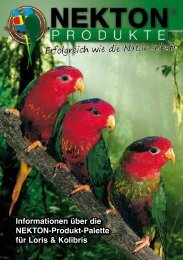Create successful ePaper yourself
Turn your PDF publications into a flip-book with our unique Google optimized e-Paper software.
Nectar-Taking Birds<br />
NEKTAR-PLUS is a complete diet in powder<br />
form especially formulated for nectartaking<br />
birds. It is an extremely valuable bird<br />
food whose ingredients and blend meet the<br />
requirements of even the most sensitive<br />
members of the humming bird family. This<br />
formula makes it an ideal diet for ALL species<br />
of nectar-taking birds, but in this booklet<br />
we want to concentrate on two groups in this<br />
category - the humming bird family and the<br />
sunbird family. On the following pages we<br />
will go into detail on the life, care and feeding<br />
of these birds. Here in the introduction we<br />
would like to at least mention the other species<br />
of birds that would thrive on NEKTAR-<br />
PLUS in captivity.<br />
First of all there is the genus of Honeycreepers<br />
(Cyanerpes), or Honey-suckers as some<br />
people call them and which more recent literature<br />
classifies as related to the Tanagers,<br />
and the sub-genus the Bananaquit. These<br />
species are all to be found in Central and<br />
South America and feed mainly on the nectar<br />
of various flowers. They have become very<br />
popular among bird lovers, many of whom<br />
have discovered how valuable and convenient<br />
NEKTAR-PLUS is as a food for these<br />
birds in captivity. We ourselves kept bananaquits<br />
successfully for over two years on our<br />
station, solely on NEKTAR-PLUS. They were<br />
in excellent health and first-class condition<br />
throughout.<br />
It has also been proved that even the Flowerpiercer<br />
(Diglossa family), once regarded as a<br />
„problem child“ with regard to feeding, can be<br />
kept on NEKTAR-PLUS without any trouble<br />
whatsoever.<br />
We have learned from numerous breeders<br />
that they have been very satisfied with the<br />
improved health and appearance of their<br />
White-Eyes (Zosteropidae) fed on NEKTAR-<br />
PLUS, although these birds come from such<br />
different parts of the world as Ethiopia, Japan<br />
and Australasia. There are even owners of<br />
exotic finches who insist on feeding their<br />
birds on NEKTAR-PLUS during breeding or<br />
shortly before shows and swear by its positive<br />
effect on the condition.<br />
In addition we have found that NEKTAR-<br />
PLUS can also be used as an excellent and<br />
complete diet for small lorikeets. For some<br />
time now we have been rearing and keeping<br />
such lorikeets as the Whiskered and Redflanked<br />
Lorikeet on a sole diet of NEKTAR-<br />
PLUS without any loss whatsoever. In fact<br />
results have been even better than feeding<br />
them on NEKTON-LORI, our nectar-concentrate<br />
for lories.<br />
NEKTAR-PLUS, therefore, with its wellbalanced<br />
composition can be given to practically<br />
all types of birds feeding on nectar, not<br />
forgetting the Flower Peckers (dicaeidae)<br />
and the Honey-eaters (Meliphagidae).<br />
Further NEKTON products with a high protein<br />
content are NEKTON-LORI, a complete<br />
diet for all lories and hanging parrots; the<br />
NEKTON-TONICs, K for seed-eaters, I for<br />
insect-eaters, F for fruit-eaters and R for<br />
insect-taking reptiles. Details of these and all<br />
other NEKTON products will be gladly given<br />
on request.<br />
HUMMING BIRDS<br />
How and Where They Live<br />
Humming birds belong entirely to the New<br />
World, being distributed throughout both<br />
American continents. The over 300 different<br />
types of hummers form the second largest<br />
family of birds to be found in the neo-tropical<br />
area. The greatest variety of species is<br />
centred around the Equator, with the largest<br />
concentration of varieties in Ecuador,<br />
Colombia and Venezuela. Their distribution,<br />
however, covers both American continents<br />
from the southern tip of South America to the<br />
cold wilds of South Alaska in the North. It is<br />
this huge variety and the vast area of distribution<br />
that prove how wrong popular belief<br />
can be. Clearly the common idea of jungle<br />
vegetation, high humidity and temperatures<br />
as the typical ambience for humming birds



